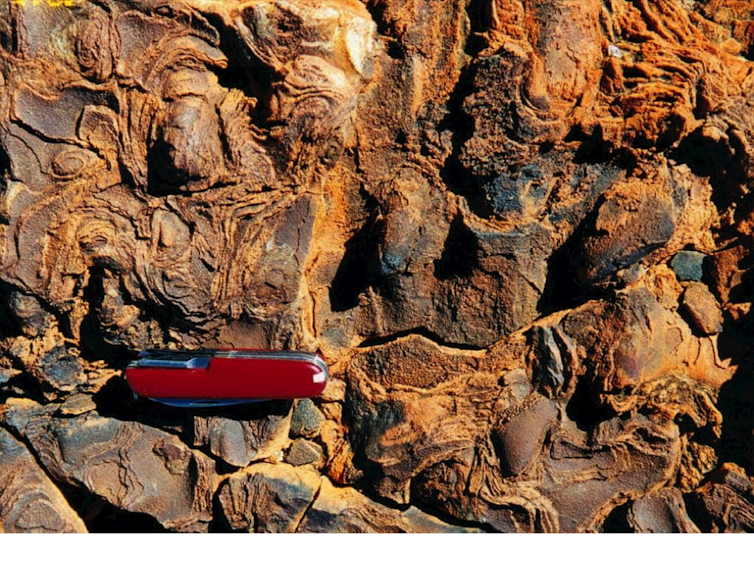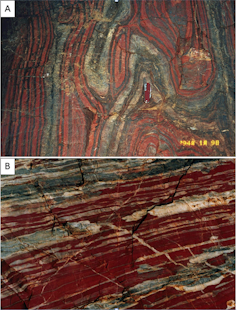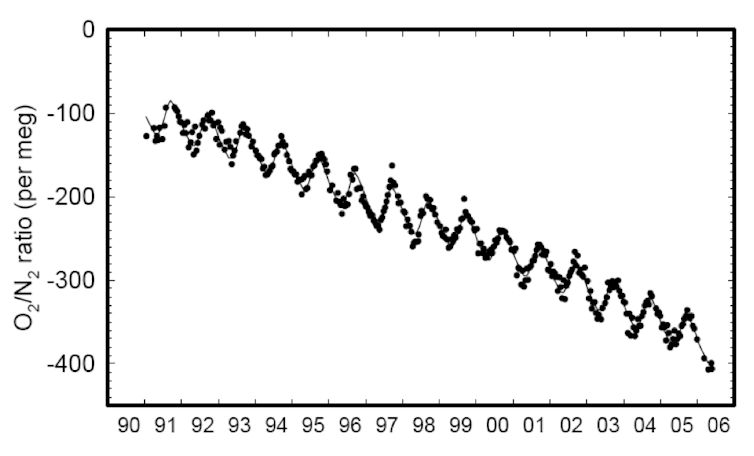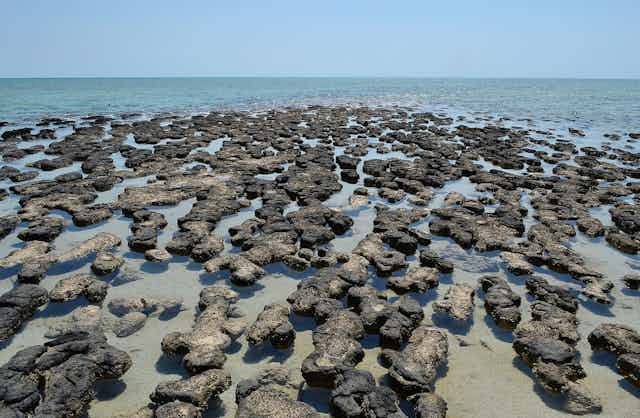How long has Earth’s atmosphere included oxygen? A recent paper suggests low levels of oxygen appeared in the atmosphere approximately 2.95 billion years ago. That’s about 550 million years earlier than previously thought.
Understanding the origin of atmospheric oxygen is central to study of the evolution of life.
The birth of oxygen
Early biospheres consisted of extremophile bacteria living in high-temperature, low oxygen and low-pH (acid) environments, such as volcanic vents in the deep ocean.
CO2 and H2 reacted with one another to produce organic molecules and methane. Organic matter was produced where carbon dioxide, water and solar light energy combine to form carbohydrates and oxygen. Cyanobacteria released oxygen near the surface of the sea.
The oldest known examples are the microbial colonies known as stromatolites, which grew upward in shallow water toward the sun around 3.43 billion years ago, as found in the Pilbara region of Western Australia (see the image below).

Oxygen levels during Earth’s first 2 billion years are estimated as 10−5 times present levels. According to researchers Kasting and Donahue, at that stage free oxygen would probably had a toxic effect on primitive life forms.
Oxygen’s evolution
Pioneering studies by Heinrich Holland suggest several stages in evolution of oxygen.
Around 3.85 billion years ago, the atmosphere was largely or entirely devoid of oxygen. So were the oceans, with the possible exception of oxygen oases in the shallow oceans.
Around 2.45 million years ago, atmospheric oxygen levels rose sharply, levelling out around 1.85 million years ago. The shallow oceans became mildly oxygenated, while the deep oceans continued to be anoxic.
About 635 million years ago the rise of Ediacara fauna, found in the Flinders Ranges in South Australia, signifies a global rise in atmospheric oxygen level. This is because the protein molecule of multicellular organisms requires oxygen for its synthesis.

Atmospheric oxygen levels rose significantly from about 0.54 million years ago, reached a peak in the Permian about 300 – 250 million years ago, then dropped to the Jurassic from about 200 million years ago, following which they rose slowly to present levels, shown in the graph left.
Some authors suggest the rise in oxygen about 2,470 – 2,450 million years ago was related to extensive volcanic activity, a change in the reduction-oxidation state of the volcanic gases, glaciation and deposition of banded iron formations.
Kump and Kasting suggest variations) in the oxygen level of the Earth mantle and its magmatic products had an effect on the composition of the ocean and atmosphere.
How do we know when oxygen formed?

The abundance of banded iron formations and iron-rich jaspillite (see image on the right) in early sediments can tell us a lot about oxygen levels.
Some researchers believe that, under the low-oxygen conditions of the Archaean atmosphere, iron dissolved in the sea water as ferrous oxide (FeO), then was precipitated as ferric oxide (Fe2O3) through the oxidising activity of bacteria and/or by photolysis, which is where sunlight photons trigger the chemical dissociation of water.
In some instances the increase in ferrous oxide concentration of the early oceans followed major asteroid impacts, with likely erosion During these stages breakdown of iron-bearing minerals in the basalts and enhanced supply of FeO to the oceans were followed by oxidation and precipitation of banded iron formations.
The presence of unoxidised sulphide (metal-sulphur minerals) and uraninite (UO2) grains in sediments is taken as evidence for low levels or absence of oxygen. Studies of sulphur isotope relations allow researchers to make inferences about whether there was an ozone layer in the early atmosphere.
According to Kopp et al, about 2.3-2.2 million years ago oxygen - produced by cyanobacteria - could have destroyed a methane-rich greenhouse atmosphere and triggered a glacial event on timescales as short as 1 million years. This suggests oxygenic cyanobacteria evolved and radiated shortly before that time.
It has been suggested the earliest cyanobacteria evolved around 2.7 million years ago and that transient atmospheric oxygenation occurred as far back as 2.7-2.6 million years ago. However, the recent paper by Crowe et al suggests an even earlier rise of oxygen.
This inference is based on oxidation weathering detected by the researchers when they looked at the 2.95-billion-year-old palaeo-soils and banded iron formations of the Pongola Supergroup, in South Africa. The researchers noted the distribution of chromium isotopes and redox-sensitive metals in these soils. Chromium isotopes are sensitive to reactions involving oxygen, with the heavier isotope being slightly more soluble when oxidised than the lighter one.
Based on these researchers’ calculations, atmospheric oxygen concentrations at that stage were 3 × 10−4 times the present levels. The extra oxygen was in part converted in the atmosphere into ozone (O3), which filters damaging solar ultraviolet radiation, allowing new microbial species to emerge.
Oxygen and life
When late Proterozoic oceans became enriched with oxygen, it allowed protein chains to develop. This meant Ediacara fauna – the earliest known multicellular organisms – could emerge in the oxygenated oceans.
Canfield et al suggested oxygen levels were the critical factor allowing multicellular animals to emerge. A prolonged stable oxygenated environment may have permitted bilateral mobile animals to emerge after glacial termination about 635 million years ago
This was followed by the [onset of the Cambrian explosion](http://en.wikipedia.org/wiki/Wonderful_Life_(book%29) of life, when a rich variety of organisms developed.
There were high levels of oxygen during the late Carboniferous-Permian and Cainozoic ice ages. These levels are thought to relate at least in part to the strong growth of mid and low-latitude forests, which released oxygen through photosynthesis.
Conversely, warmer periods such as the early Cretaceous and Jurassic and early Devonian are characterised by oxygen levels below ~15%. This is likely because of extensive burning of terrestrial vegetation.

Current climate change constitutes a major oxidation event. More than 560 billion tons of carbon have to date been released from geological deposits and from land clearing. This carbon is oxidised by interaction with atmospheric oxygen, lowering its level by a small amount (see image above).
A further decline in the atmospheric level of oxygen would be reversed by ensuing tropical conditions under higher temperatures, evaporation and rainfall in some parts of the world, whereas in other regions development of draughts would result in further burning and oxidation, the final balance of oxygen remaining unknown.

